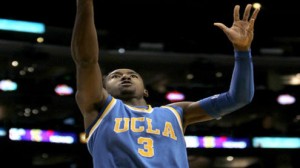Oregon Ducks AT UCLA Bruins
Feb 10, 2011 at 10:30 PM EST
Opening Line: UCLA -9
Current Line: UCLA -9
Opening Total: 135.5
Current Total: 136.5
Opening Moneyline: UCLA -450 / Ore +370
Current Moneyline: UCLA -500 / Ore +350

Tonight’s Pac-10 matchup features two teams that are both hot. Oregon, despite being only 1 game above .500, has won 5 of their last 7 games and are 5-6 in the Pac-10 for 6th place. UCLA has won 7 of their last 8 to pull to 16-7 overall and with a 7-3 record in the Pac-10, they are in second in the conference. Yet, despite UCLA’s dominant record, they don’t have a very high point differential. It is +4.2. Only 5 of their 15 wins were by double digits; the rest for the most part were very close games, so that accounts for why a +4.2 point differential can obtain a 16-7 record. Oregon, despite their losing record, is positive as well, at +1.6. Both teams score roughly the same (Ore 70.3 vs UCLA 71.4) and give up roughly the same (Ore 68.7 vs UCLA 67.3).
UCLA received 9 votes in the coaches’ poll for rankings and received none at all in the AP top 25. Their 16-7 record is better than several of the ranked teams, but due to the strength of their schedule they are not being regarded as a top 25 team. Oregon will be yet another mediocre opponent and they only face one ranked team between now and March Madness (they play #16 Arizona on February 26th).
Some betting trends:
Oregon is 6-19 SU in their last 25 road games and 2-5 ATS in their last 7 games on the road against UCLA. Oregon is 1-6 SU in their last 7 road games against UCLA and the total has gone UNDER in 4 of Oregon’s last 6 games on the road at UCLA.
UCLA is 7-1 SU in their last 8 games and the total has gone UNDER In 7 of UCLA’s last 10 games. UCLA is 10-1 SU in their last 11 home games and the total has gone UNDER in 4 of UCLA’s last 5 games at home. UCLA is 2-4 ATS in their last 6 against the Ducks and they are 10-3 SU in their last 13 games against Oregon. UCLA is 6-1 SU in their last 7 home games against Oregon.
Oregon is led by 6’6″ senior forward Joevan Catron. Catron averages 16.0 points per game 6.7 rebounds per game and 1.0 steals. He’s a poor three point shooter (28%) but has only attempted 25 threes in Oregon’s 23 games. He has scored in double figures in 19 of their 23 games and has scored more than 20 seven times. His best outing of the season came in a 75-72 loss to San Jose State when he scored 25 points and grabbed 9 rebounds. He’s averaging 18.5 points per game over his last 4 games, 3 of which Oregon has won. They are 2-2 in the games in which he failed to reach double figures, but it isn’t because they have a strong supporting cast. They have only one other scorer in double figures, 6’6″ sophomore forward E.J. Singler. Singler averages 11.2 points per game and 5.7 boards. He plays slightly more minutes than Catron and is really the only other viable threat to speak of on the Oregon roster. No player on Oregon plays more than 30 minutes a game and their rotation goes 9 deep. Catron and Singler will have to have big games for Oregon to have any chance at covering the spread; they simply don’t have any other effective weapons offensively.
All five UCLA starters score in double figures. They are led by Reeves Nelson, a 6’8″ sophomore forward who averages 14.1 points per game and 8.8 rebounds per game. He’s had 12 double doubles and has recorded a double double in UCLA’s last 6 games. They are 8-4 in games which Nelson has a double double and his best game of the year came in a 57-44 win over Pacific, when he scored 21 points and grabbed 14 rebounds (13 defensive). Backing up Nelson is the duo of Malcolm Lee and Tyler Honeycutt. Lee and Honeycutt both average 13 points per game and UCLA’s starting five accounts for 61.4 points, 86% of their offense. No bench players on UCLA make any real viable contributions. Oregon doesn’t have the depth to exploit this, however, so expect UCLA’s starters to log their typical number of minutes since Oregon can’t press or apply extra pressure to wear down the UCLA guards.














